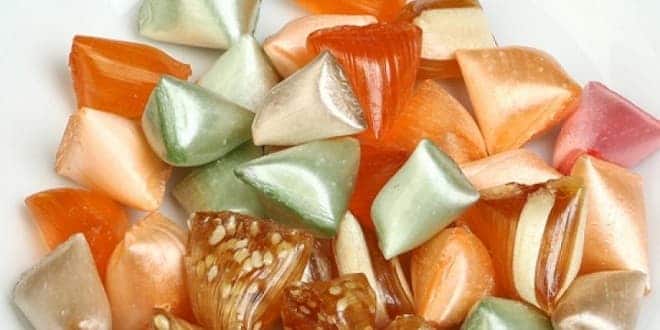Özet
Akide şekeri, Osmanlı mutfağından günümüze kadar gelen, sert şeker olarak da bilenen, geleneksel şekerleme ürünüdür. Kaliteli akide sert, parlak ve camsı karakterde olan ve bu özelliğini uzun süre koruyan şekerlemelerdir. Klasik akide şekerlerinin en büyük problemi, bünyesindeki hava kabarcıkları ve çevreden nem çekmesi sonucu renginin matlaşıp, ağarması ve serliğini kaybetmesidir. Bu çalışmada, klasik akide şekerinin raf ömrünü uzatmak amacıyla klasik pişirme işlemi (168 C) ile spreyli vakum ortamında pişirme (138 C) işlemlerinin son ürün kalitesi ve raf ömrüne etkilerinin karşılaştırılması amaçlanmıştır. Beş kg şeker lapası ile yapılan ön denemeler sonucunda spreyli vakum sisteminin 135 C ve 500 milibar vakum uygulamasının optimum norm oluşturduğu, ancak 50 kg üzerinden yürütülen endüstriyel üretim şartlarında 138 C nin daha uygun olduğu tespit edilmiştir. Akide şekeri örneklerinin renk değişimleri (L, a ve b), %65±5 nispi nemde 15 günlük rutubetli şartlarda su absorbsiyonu (higroskopite), ağızda erime durumlarını da ortaya koymak için 37 C’da çözünürlük analizleri, aromatik profili değerlendirmede panel testi gerçekleştirilmiş- tir. Sonuç olarak, spreyli vakumlu pişirme sisteminin, klasik sisteme göre çok daha sert, camsı, raf ömrü çok daha uzun, renk ve aromatik profili muhafaza açısından daha etkili akide şekeri verdiği tespit edilmiştir.
Anahtar kelimeler: Akide şekeri, sert şeker, şekerleme, vakum sprey, klasik sistem
EFFECT OF CLASSICAL AND VACUUM SPRAY COOKING METHODS ON SOME QUALITY CHARACTERISTICS AND SHELF LIFE OF AKIDE CANDY
Abstract
Akide candy is a traditional candy product coming from Ottoman kitchen, and also known as hard candy. Quality Akide has tough, bright and glassy characteristics and these properties can be preserved for a long time. However, the major challenge in the production of Akide candy is that it loses its hardness as well as bleaches and tarnishes as a result of the bubbles formed in its structure and getting humidified from the environment. In this study, it was aimed to compare the effect of spray cooking (138 C) under vacuum on the quality of end product with that of the classic cooking (168 C). As a result of the preliminary tests ap- plied using 5 Kgs of sugar pulp, it was concuded that sprayed vacuum system with 500 milibar vacuum ap- plication at 135 ºC resulted in optimum norm, however, 138 ºC was observed to be more suitable in respect of the industrial production conditions carried out on 50 kg. For this purpose, color analysis (L, a and b), water absorption analysis during 15 days at 65±5% humidity (hygroscopicity), solubility analysis in water at 37 ºC to estimate mouth solubility and sensory analysis to determine aromatic profile were conducted. As a conclusion, it was determined that spray cooking under vacuum resulted in quite harder and vitre- ous structure product with much longer shelf life and better product in respect of protection of color and aromatic profile than did classical cooking.
Keywords: Akide candy, hard candy, sugar cooking, spray cooking under vacuum, classic system
…

